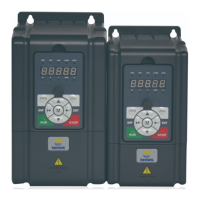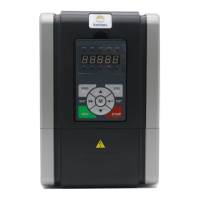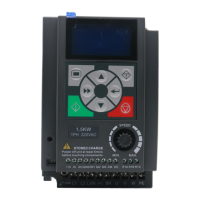Chapter 5 Operation Instructions Shenzhen Hpmont Technology Co., Ltd
―34― HD20 Series Inverters User Manual
5.1.2 Inverter Frequency Setting Source
The final setting frequency of the HD20 inverter results from calculating (defined by F19.01) the
value of 5 master setting sources (set by F00.10) and 6 auxiliary setting sources (set by F19.00).
Note:
The frequency will be set by master setting source if the auxiliary is the same as the master
setting source.
Master setting frequency sources
0: Display panel digital setting, change the value by and keys. (Initial value is set by
F00.13)
1: Terminal digital setting, change the value by terminals UP/DN. (Initial value is set by F00.13)
2: SCI communication digital setting. (Initial value is 0)
3: Analogue setting
4: Terminal pulse setting (F15.05 = 53)
Auxiliary setting frequency sources
0: No auxiliary frequency
1: Digital setting 1, change the value by and keys. (Initial value is set by F19.03)
2: Digital setting 2, change the values by terminals UP/DN. (Initial value is set by F19.03)
3: Digital setting 3, SCI communication direct setting. (Initial value is 0)
4: Analogue setting
5: Terminal pulse setting (F15.05 = 53)
6: Process PID output setting
5.1.3 Inverter Status
HD20 inverter has three running status: Stop, Run and Motor parameters auto-tuning.
Stop: After the inverter is switched on and initialized, if no run command inputs or the stop
command is given, there is no output from U/V/W of the inverter. Therefore the RUN indicator will
flash.
Run: The inverter starts output after it receives the run command. There is output from U/V/W of
the inverter, and the RUN indicator is lighting.
Motor parameters auto-tuning: If the inverter receives the run command after the function
parameter F08.06/F13.07 set as 1 or 2, the inverter will enter motor parameters auto-tuning
status. Then enters stop status if the auto-tuning process is completed.

